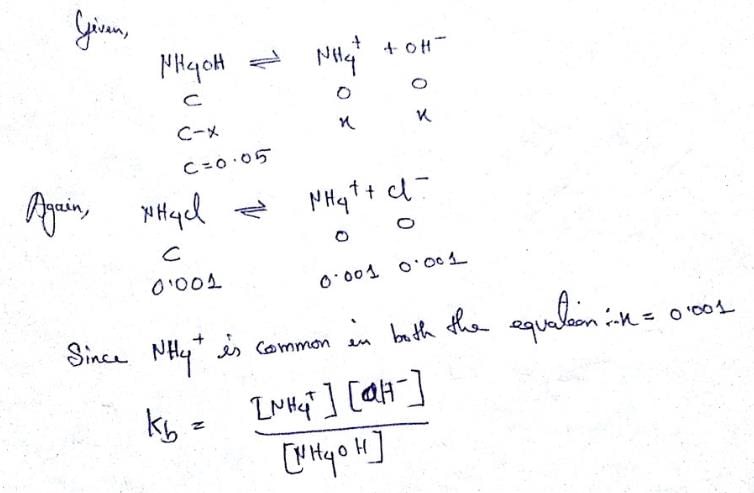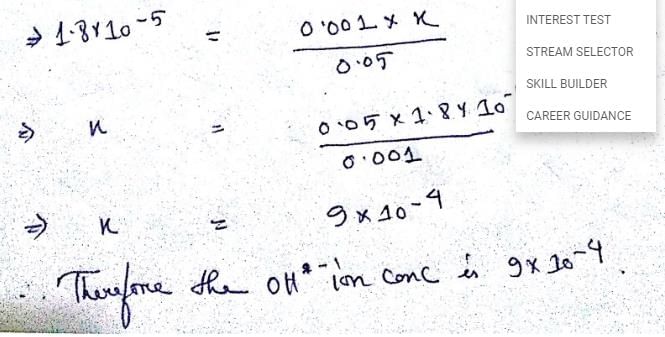Class 11 Exam > Class 11 Questions > 0.05 M ammonium hydroxide solution is dissolv...
Start Learning for Free
0.05 M ammonium hydroxide solution is dissolved in 0.001M ammonium chloride solution.what will be the OH- ion concentration of the solution ?
Verified Answer
0.05 M ammonium hydroxide solution is dissolved in 0.001M ammonium chl...
Ans.


 This question is part of UPSC exam. View all Class 11 courses
This question is part of UPSC exam. View all Class 11 courses
Most Upvoted Answer
0.05 M ammonium hydroxide solution is dissolved in 0.001M ammonium chl...
Introduction:
In this scenario, we have a 0.05 M solution of ammonium hydroxide (NH4OH) and a 0.001 M solution of ammonium chloride (NH4Cl). We need to determine the concentration of hydroxide ions (OH-) in the resulting solution when these two solutions are mixed together.
Ammonium Hydroxide (NH4OH):
Ammonium hydroxide is a weak base that partially dissociates in water. It reacts with water to produce ammonium ions (NH4+) and hydroxide ions (OH-).
NH4OH ⇌ NH4+ + OH-
The equilibrium constant for this reaction is given by the equilibrium expression:
Kw = [NH4+][OH-]
Ammonium Chloride (NH4Cl):
Ammonium chloride is a salt that completely dissociates in water. It breaks down into ammonium ions (NH4+) and chloride ions (Cl-).
NH4Cl → NH4+ + Cl-
Formation of NH4+ and OH- Ions:
When we mix the ammonium hydroxide solution with the ammonium chloride solution, the ammonium ions (NH4+) from both solutions will remain in solution. However, the hydroxide ions (OH-) from the ammonium hydroxide will react with the hydrogen ions (H+) from the dissociation of water to form water molecules.
NH4OH + H2O ⇌ NH4+ + OH- + H2O
The concentration of hydroxide ions (OH-) in the resulting solution will depend on the concentration of ammonium hydroxide and the extent of its dissociation. Since ammonium hydroxide is a weak base, it will only partially dissociate, leading to a smaller concentration of hydroxide ions compared to the concentration of ammonium hydroxide.
Calculating the OH- Ion Concentration:
To calculate the OH- ion concentration, we need to consider the initial concentration of ammonium hydroxide and the extent of its dissociation. Since the concentration of ammonium hydroxide is given as 0.05 M, we can assume that the concentration of NH4+ ions is also 0.05 M.
Since ammonium hydroxide is a weak base, we can assume that its dissociation is negligible compared to the concentration of NH4+. Therefore, the concentration of OH- ions can be approximated as the same as the concentration of NH4+ ions, which is 0.05 M.
Conclusion:
In conclusion, when a 0.05 M ammonium hydroxide solution is dissolved in a 0.001 M ammonium chloride solution, the concentration of hydroxide ions (OH-) in the resulting solution is approximately 0.05 M. This is because the weak base ammonium hydroxide partially dissociates to produce ammonium ions (NH4+) and hydroxide ions (OH-), and the concentration of OH- ions can be approximated as the same as the concentration of NH4+ ions.
In this scenario, we have a 0.05 M solution of ammonium hydroxide (NH4OH) and a 0.001 M solution of ammonium chloride (NH4Cl). We need to determine the concentration of hydroxide ions (OH-) in the resulting solution when these two solutions are mixed together.
Ammonium Hydroxide (NH4OH):
Ammonium hydroxide is a weak base that partially dissociates in water. It reacts with water to produce ammonium ions (NH4+) and hydroxide ions (OH-).
NH4OH ⇌ NH4+ + OH-
The equilibrium constant for this reaction is given by the equilibrium expression:
Kw = [NH4+][OH-]
Ammonium Chloride (NH4Cl):
Ammonium chloride is a salt that completely dissociates in water. It breaks down into ammonium ions (NH4+) and chloride ions (Cl-).
NH4Cl → NH4+ + Cl-
Formation of NH4+ and OH- Ions:
When we mix the ammonium hydroxide solution with the ammonium chloride solution, the ammonium ions (NH4+) from both solutions will remain in solution. However, the hydroxide ions (OH-) from the ammonium hydroxide will react with the hydrogen ions (H+) from the dissociation of water to form water molecules.
NH4OH + H2O ⇌ NH4+ + OH- + H2O
The concentration of hydroxide ions (OH-) in the resulting solution will depend on the concentration of ammonium hydroxide and the extent of its dissociation. Since ammonium hydroxide is a weak base, it will only partially dissociate, leading to a smaller concentration of hydroxide ions compared to the concentration of ammonium hydroxide.
Calculating the OH- Ion Concentration:
To calculate the OH- ion concentration, we need to consider the initial concentration of ammonium hydroxide and the extent of its dissociation. Since the concentration of ammonium hydroxide is given as 0.05 M, we can assume that the concentration of NH4+ ions is also 0.05 M.
Since ammonium hydroxide is a weak base, we can assume that its dissociation is negligible compared to the concentration of NH4+. Therefore, the concentration of OH- ions can be approximated as the same as the concentration of NH4+ ions, which is 0.05 M.
Conclusion:
In conclusion, when a 0.05 M ammonium hydroxide solution is dissolved in a 0.001 M ammonium chloride solution, the concentration of hydroxide ions (OH-) in the resulting solution is approximately 0.05 M. This is because the weak base ammonium hydroxide partially dissociates to produce ammonium ions (NH4+) and hydroxide ions (OH-), and the concentration of OH- ions can be approximated as the same as the concentration of NH4+ ions.
Community Answer
0.05 M ammonium hydroxide solution is dissolved in 0.001M ammonium chl...
Ans.


Attention Class 11 Students!
To make sure you are not studying endlessly, EduRev has designed Class 11 study material, with Structured Courses, Videos, & Test Series. Plus get personalized analysis, doubt solving and improvement plans to achieve a great score in Class 11.

|
Explore Courses for Class 11 exam
|

|
Similar Class 11 Doubts
0.05 M ammonium hydroxide solution is dissolved in 0.001M ammonium chloride solution.what will be the OH- ion concentration of the solution ?
Question Description
0.05 M ammonium hydroxide solution is dissolved in 0.001M ammonium chloride solution.what will be the OH- ion concentration of the solution ? for Class 11 2024 is part of Class 11 preparation. The Question and answers have been prepared according to the Class 11 exam syllabus. Information about 0.05 M ammonium hydroxide solution is dissolved in 0.001M ammonium chloride solution.what will be the OH- ion concentration of the solution ? covers all topics & solutions for Class 11 2024 Exam. Find important definitions, questions, meanings, examples, exercises and tests below for 0.05 M ammonium hydroxide solution is dissolved in 0.001M ammonium chloride solution.what will be the OH- ion concentration of the solution ?.
0.05 M ammonium hydroxide solution is dissolved in 0.001M ammonium chloride solution.what will be the OH- ion concentration of the solution ? for Class 11 2024 is part of Class 11 preparation. The Question and answers have been prepared according to the Class 11 exam syllabus. Information about 0.05 M ammonium hydroxide solution is dissolved in 0.001M ammonium chloride solution.what will be the OH- ion concentration of the solution ? covers all topics & solutions for Class 11 2024 Exam. Find important definitions, questions, meanings, examples, exercises and tests below for 0.05 M ammonium hydroxide solution is dissolved in 0.001M ammonium chloride solution.what will be the OH- ion concentration of the solution ?.
Solutions for 0.05 M ammonium hydroxide solution is dissolved in 0.001M ammonium chloride solution.what will be the OH- ion concentration of the solution ? in English & in Hindi are available as part of our courses for Class 11.
Download more important topics, notes, lectures and mock test series for Class 11 Exam by signing up for free.
Here you can find the meaning of 0.05 M ammonium hydroxide solution is dissolved in 0.001M ammonium chloride solution.what will be the OH- ion concentration of the solution ? defined & explained in the simplest way possible. Besides giving the explanation of
0.05 M ammonium hydroxide solution is dissolved in 0.001M ammonium chloride solution.what will be the OH- ion concentration of the solution ?, a detailed solution for 0.05 M ammonium hydroxide solution is dissolved in 0.001M ammonium chloride solution.what will be the OH- ion concentration of the solution ? has been provided alongside types of 0.05 M ammonium hydroxide solution is dissolved in 0.001M ammonium chloride solution.what will be the OH- ion concentration of the solution ? theory, EduRev gives you an
ample number of questions to practice 0.05 M ammonium hydroxide solution is dissolved in 0.001M ammonium chloride solution.what will be the OH- ion concentration of the solution ? tests, examples and also practice Class 11 tests.

|
Explore Courses for Class 11 exam
|

|
Suggested Free Tests
Signup for Free!
Signup to see your scores go up within 7 days! Learn & Practice with 1000+ FREE Notes, Videos & Tests.

























